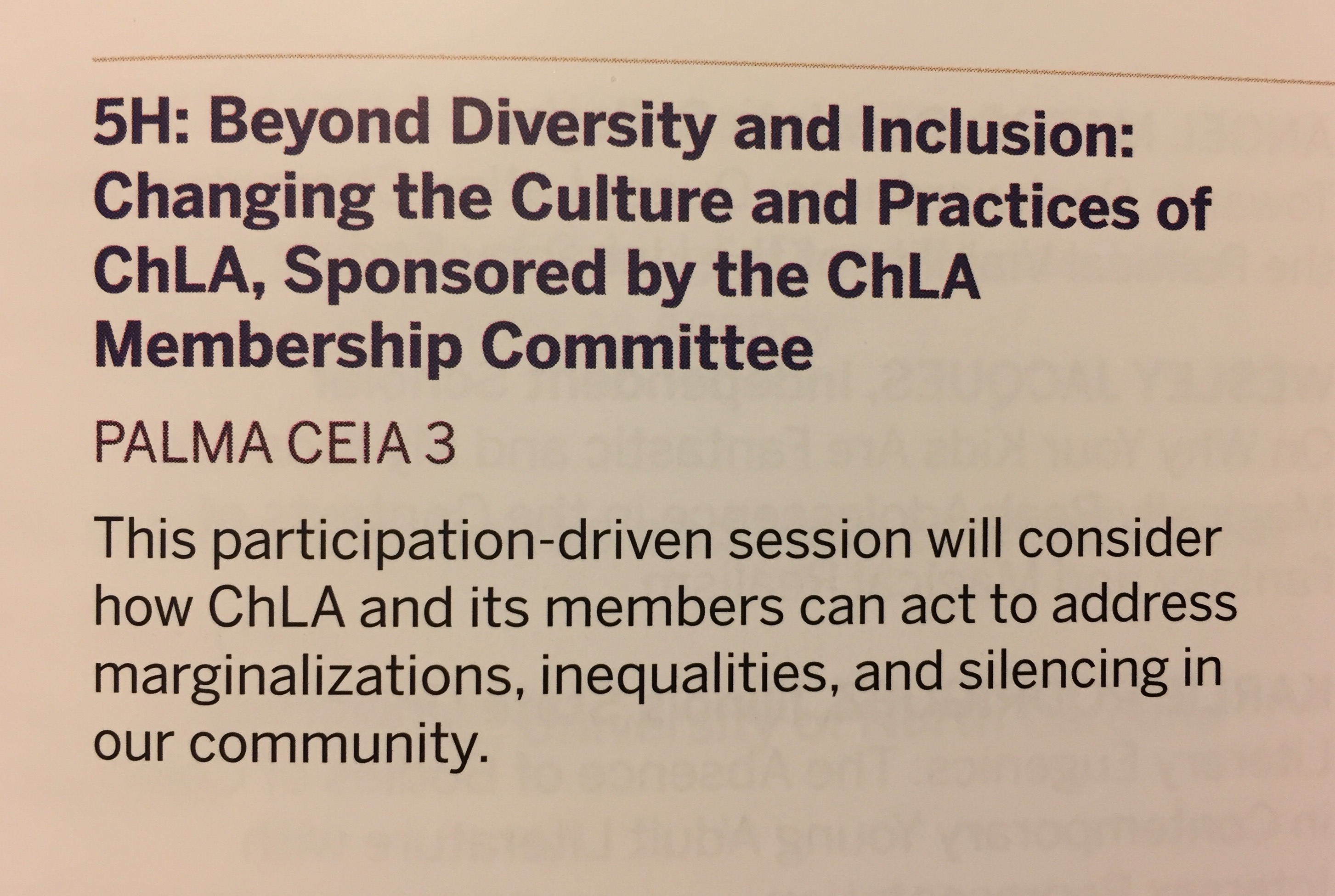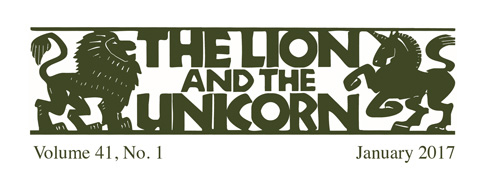The most powerful panel at last year’s Children’s Literature Association conference was “Needs of Minority Scholars,” featuring Sarah Park Dahlen, Ebony Elizabeth Thomas, Laura M. Jiménez, and Marilisa Jiménez García.
- If you are at the Children’s Literature Association conference right now, I encourage you to attend the follow-up session, “Beyond Diversity and Inclusion: Changing the Culture and Practices of the ChLA.” It will be held tomorrow (Thursday, 22 June) at 3:30 pm in Palma Ceia 3.

- Wherever you are, I encourage you to read last year’s panel, published in the latest issue of The Lion and the Unicorn (January 2017). The panel’s papers published there, instead of in the organization’s own Children’s Literature Association Quarterly, because – as Michelle Martin points out in her contribution to the issue – “because the editors [of ChLAQ] didn’t consider these pieces research.” That fact proves the necessity of that panel, of tomorrow’s panel, and of the ChLA’s need to walk the walk – and not just talk the talk. As Kate Slater (the panel’s chair and editor of the special section) asks, “What if every marginalized scholar felt welcomed within the field of children’s and young adult literature studies? What if our community listened–truly listened–to their experiences, words, and perspectives, even when that experience of listening requires us to look uncomfortably at ourselves? And, perhaps most importantly: what now? How will we act together to make these ‘what ifs’ a reality?”

If you have any interest in children’s literature or in making your scholarly/professional organization (whatever its subject) a truly diverse one, I encourage you to read these essays. (Note: Ebony Thomas’s piece is not included, but [as you will have guessed already] a new piece by Michelle Martin is included. And the other three panelists are there.)
Need a brief summary of why? I’ll offer succinct (and thus incomplete) highlights of each essay here. ALSO: please access these via your institution because doing so helps underwrite the cost of the scholarly journal. BUT if you cannot get behind the paywall, email me and I will send you pdfs. My address is at right, under “A note on mp3s.”
Sarah Park Dahlen, A Step from Heaven: On Being a Woman of Color in Children’s Literature Studies
- on the need for mirrors: on the experience of reading An Na’s A Step from Heaven for the first time, Dahlen writes, “I wasn’t alone. I saw for the first time that these things happened to other people too, other people who looked like me. Whose parents looked like mine. Whose mother suffered as mine did. Whose father was absent as mine was.”
- on being the visible embodiment of racial identity: “I do not leave my personal history or identity at the door when I enter a classroom. As Ebony Elizabeth Thomas said at the Children’s Literature Association 2016 conference’s Minority Scholars panel, students read our bodies before we even open our mouths. How they treat us is based, first and largely, on how they read our racial identities. My Korean body disrupts assumptions about who is an authority in teaching children’s literature.”
- on point: “We who are racially Other are fatigued by repeated distortions and erasure, and by exposure to micro- and macroaggressions in our daily lives and in spaces that masquerade as safe but actually exist to uphold the status quo. Racial battle fatigue is real. White fragility is entirely different. White fragility maintains power.”
Michelle Martin, Brown Girl Dreaming of a New ChLA
- on the insufficiency of good intentions. I (and many others) are fond of quoting the organizations unofficial mantra: “We don’t eat our young,” which past president Roberta Trites likes to say. It’s true: ChLA is welcoming. But it also isn’t equally welcoming to everyone, as Martin reminds us: “when scholars come through the doctoral pipeline whose educational experiences have been rife with racial and gender microaggressions from more seasoned scholars (even well-meaning ones) and peers and when they, like Marilisa Jiménez García, constantly struggle to have their work acknowledged as (1) scholarship and (2) relevant, ‘we don’t eat our young’ is little comfort. Some of us feel that we’ve been eaten our entire careers.”
- on how structural power magnifies microagressions; or, how the powerful forget the harm they do, but the less powerful remember. Martin recounts a story shared by Tiffany MartiÌnez – a Suffolk University undergraduate, McNair Scholar, and aspiring academic – who used the word “Hence” in a paper. Her professor circled the word, opined “This is not your word,” and accused her of plagiarism. As Martin notes, “Although this incident was seismic for her, Martínez suspects that the professor might have already forgotten it.”
- on the need for scholars from outside of minoritized communities to do the research and write what she terms “crossover scholarship”: “writing crossover scholarship should not be undertaken casually but with a commitment to excellence, with humility, and with a teachable spirit.”
Laura M. Jiménez, My Gay Agenda: Embodying Intersectionality in Children’s Literature Scholarship
- on the need for an intersectional agenda: “it is not uncommon for me to be accused of having a “gay agenda.” I’ve read the phrase on student evaluations, reviewers’ comments, and heard colleagues use it to dismiss my arguments, assertions, and even my life experiences. Let me be clear, I have an agenda, and it is an out and proud agenda, but it probably isn’t the one most people assume. My agenda isn’t simply gay. My agenda is a race-class-gender-and- all-kinds-of-identities-that-make-people-uncomfortable-and-unsure agenda. In short, my agenda is an intersectional agenda.”
- on importance of teachers making their own intersectionality visible: “At the same time they read these texts I provide an authentic model of intersectionality. I say the words that my students fear. The words that need to be said out loud and often. The words Black, White, Asian, Japanese, African American, Arab, Persian, race, racism, Latinx, Chicano, women, men, Native American and First Nations, cis-gender, able, disabled, neurotypical, gay, queer . . . all the words need to be said out loud. The words that need to be talked about so these teachers get to know the feeling of these words on their tongues. I come out to my students as a complex person by addressing my intertwined identities. I am performing myself in ways that most of my students have never seen a teacher do, have never had to do themselves, and will come to recognize as one way to normalize diversity.”
- If I may, I would like to add here that it is especially important that a cisgendered straight, White, male teacher – like myself – take categories that are typically invisible (and thus normalized via their invisibility) and make them visible. We must also acknowledge how the invisibly privileged among us may fail to acknowledge or even see the ways in which we are implicated in systems of privilege and oppression (typically without our active consent). As Jiménez says, “The disruption of admitting to differences, by naming those differences and directly addressing them in a classroom, can be transformative and in that transformation, change is possible.”
- on the need to make majority communities uncomfortable: “teacher education provides opportunities for them to learn to recognize the stories they are not a part of, are not native to, are not privileged by and to hear the voices that are unfamiliar, and believe the narratives that run counter to their lived experiences. Piaget’s concept of learning has helped me understand how to challenge preservice and practicing teachers. For Piaget, learning takes place when a person experiences disequilibrium, attempts to assimilate the new information into their existing schema, and finally must change that schema to accommodate the new knowledge. But for this to happen, the learner must first recognize what is unknown, must be aware of the disequilibrium and want to change it. Disequilibrium is by definition uncomfortable; this discomfort is often caused by the mere fact that the new knowledge is in direct opposition to the learner’s existing schema”
Marilisa Jiménez García, Side-by-Side: At the Intersections of Latinx Studies and ChYALit
- on the need to dwell on intersections and contradictions. Citing Monica Brown’s Side by Side / Lado a Lado (2010) as a metaphor for this need, García writes, “The picture celebrates the coming together of Chavez and Huerta, yet we see that English and Spanish are also placed side-by-side: two languages with a violent history facing each other, but separated by a division on the page. Chavez and Huerta’s hands bridge the divide, yet that division between cultures and languages running side-by-side remains. U.S. children’s literature evidences these splits, switches, breaks, and unlikely pairings–these parallel stories and traditions greet us with a history of delight, violence, and contradiction. My research has demanded that I negotiate divisions both in the field of Latinx studies and children’s literature in order to exist in academia, and to dwell on the parallels, the intersections and the contradictions.”
- on the need to displace English’s centrality to the field (citing Emer O’Sullivan): “Emer O’Sullivan writes in the ‘Preface’ to her study, Comparative Children’s Literature (2005), that ‘[c]hildren’s literature studies in English is mainly a monolingual phenomenon, mostly dealing with the wealth of children’s literature in English-speaking countries and referring to critical material written in English. Researchers who do not write in that language generally remain internationally unnoticed’ (x). She suggests that limiting inquiry to predominately Anglo children’s materials ‘neglect[s] to adequately describe and explain the crossing of linguistic and cultural borders’ (1)”
- on the need to address diversity from more than one field: “scholars in Latinx studies rarely consider the position of literature for youth and writers for young audiences in the study of historically oppressed peoples. That is, in ethnic and postcolonial studies, literature for youth remains, for the most part, marginalized.” As she notes, “As a field, are we engaging in scholarship that values diverse communities and stories? What story does our scholarship tell about the communities and knowledges we value? Or is our scholarship centralizing only certain kinds of knowledge? I have argued in my research that you cannot know the story of American children’s and youth literature and culture without knowing the story of the Puerto Rican community in the United States; the same applies in reverse.”

Mark Luetkemeyer
Pingback: 2017 ALA – Doing the Work | sarahpark.com